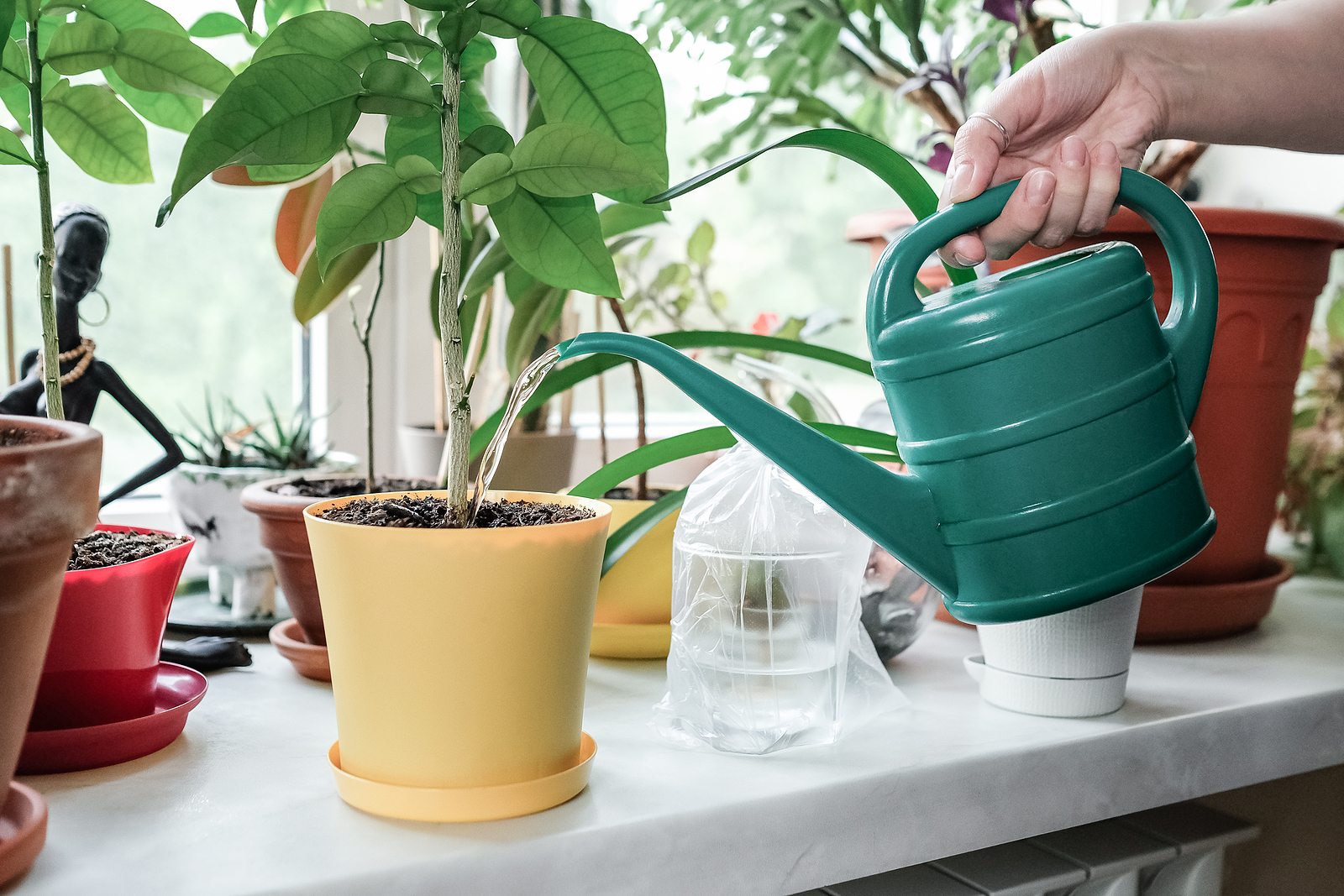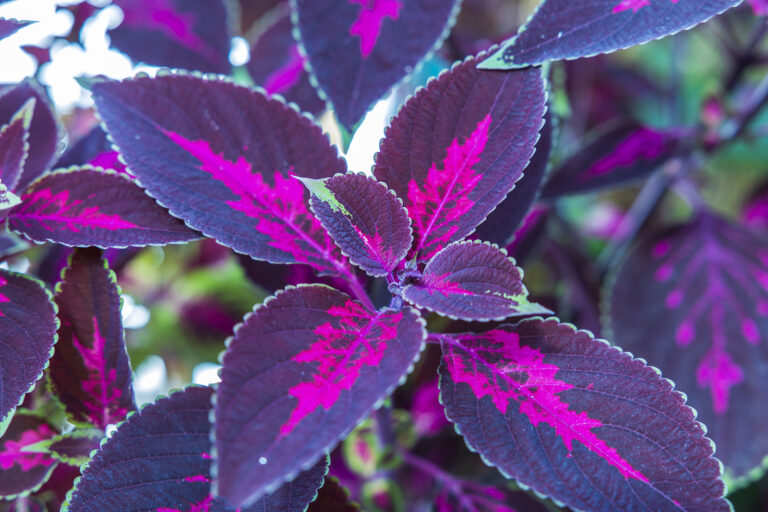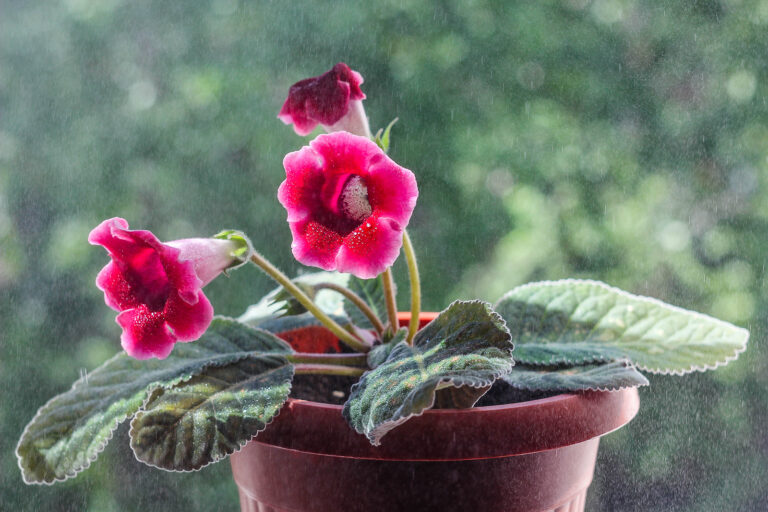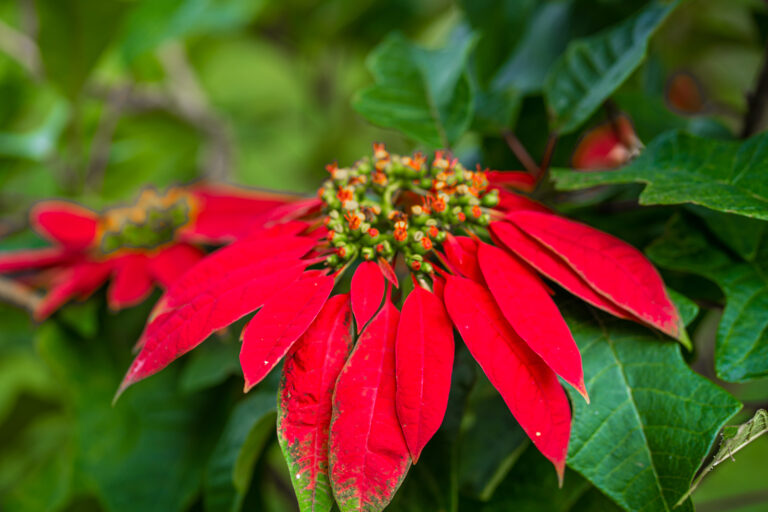Watering Houseplants
Watering houseplants requires more judgment and skill than any other gardening practice.
Watering properly is not easy when it comes to houseplants–too much water or too little water or watering at the wrong time or wrong temperature and so on. The results of watering incorrectly, though often unsuspected (or at least not associated with their true cause) are often serious, the loss of plants.
Watering principles
How to water houseplants is more experiential than explained. Nonetheless, here are the two basic principles of watering houseplants:
- Water just enough to wet the soil in the pot from top to bottom.
- Avoid keeping the soil continuously wet.
The experienced houseplant grower knows when to water by the appearance of the plants, the surface of the soil, and the conditions under which the plants are growing—easier said than done.
Plants and watering
Know the following about watering houseplants:
- Fast-growing plants and those that flower or bear fruit need more water than slower growers.
- Plants with large leaf surfaces need more water than plants with small leaves.
- Plants with soft, lush foliage need more water than plants with waxy, leathery, or succulent leaves.
- Plants need less water in winter than during summer. Some plants become dormant in winter and need less water.
- Yellow leaves, fallen leaves, and brown leaf edges or tips are signs of overwatering.
- Drooping or wilting foliage is a sign of too little water. Plants cannot tolerate wilting on a regular basis.
Pots and watering
The type of pot can affect the amount of water a houseplant needs. Here are a few things to know about pots and watering:
- Plants in clay pots will need more water that’s because clay pots are porous and absorb moisture.
- Plastic pots are nonporous and retain more moisture. Use plastic pots for moisture-loving plants.
- Glazed pots are nonporous and should be treated like plastic pots.
- Pots without drainage holes are not optimal for growing plants. If water collects at the bottom of an undrained pot, the plant roots can easily rot. Place a pot with a drainage hole inside a pot without a drainage hole; the larger pot can act as a saucer.
Watering tips
- To judge if a plant needs water, use the touch test: feel the soil with your finger to a depth of 1 inch (2.5cm); if the soil is dry at 1-inch deep, water. You also can use a moisture meter.
- To know when plants in a clay pot need water, thump the pot with a finger and note whether the sound is a “thud” or a “ring.” If it’s a thud there is plenty of water.
- Soil character influences how a plant is watered. Loose and warm soil dries out more rapidly than dense, cool soil. Most potting mixes are on the light and loose side and can require watering more often.
- If the potting mix is loose or soilless (peat-based), add sifted compost to the mix. A potting mix with compost added will hold water longer and dry out slower.
- Air temperature, the strength of light, and the amount of air circulation directly affect the water a houseplant needs.
- The warmer the indoor temperature, the more often houseplants will need water.
- The closer to a window and bright light, the more often houseplants will need water.
- The closer to a furnace vent or air-conditioning duct, the more often houseplants will need water.
- Water temperature is important; if water for plants is more than 10 degrees cooler than the air temperature, plants will suffer stress affecting growth and flowering. Let the water sit overnight in a watering can before watering houseplants.
- Use distilled water for plants if your water is hard or passes through a water softener.
How to water less
- Keep plants in small pots until the soil becomes nearly filled with roots, then shift to the next size pot, not a much larger one. Water the roots, not the soil.
- Place a plant in a clay pot inside a larger pot and fill the space between with peat moss. Keep the peat moss moist and the smaller pot will retain moisture longer.
- Place the potted plant in a saucer deep enough to hold 1 to 2 inches (2.5-5cm) of peat moss or pebbles. Add enough water to cover the peat moss or pebbles then set the potted plant on top. The soil in the pot will wick up moisture through the drainage hole; the soil in the pot will be moist but not waterlogged.
- Place the potted plant in a saucer and fill the saucer with water. Let the potted plant sit in the water for 10 minutes; the soil in the potted plant will wick up moisture. If the saucer is dry in 10 minutes, add water and wait another 10 minutes. If water remains in the saucer after 10 minutes, empty the saucer.
- Water a houseplant with a wick: take a length of twine made of cotton or other natural fiber and separate the strands at one end; soak the twine in water then draw the separated end up through the pot drainage hole and cover it with soil; place the other end of the twine in a reservoir of water below the pot. The wick will draw moisture up into the soil for a week or more.
- Every few months, place the pot in the kitchen sink or bathtub and spray the leaves with water and water the plant. Let the pot sit for 30 minutes to allow excess water to drain away.
Houseplants and humidity
Most houseplants like moist air. They are constantly losing water to the air through their leaves in a process called transpiration. Transpiration is slowed when the surrounding air is moist.
Relative humidity measures moisture in the air. A houseplant grows best when the relative humidity is about 50 percent. The relative humidity in most homes is 10 to 20 percent.
Plants in dry air may start to wither. Here are ways to keep the air around houseplant humid:
- Place a portable electric humidifier near plants.
- Spray a fine mist in the air around plants with a plastic or metal mister.
- Place 1 inch of small pebbles in a waterproof tray. Fill the tray with water to a level just below the surface of the pebbles. Place potted plants on the pebbles; group the plants close together. Check the tray periodically and refill it when necessary being careful not to raise the water level above the surface of the pebbles.
- Water evaporates from a plant’s leaves during transpiration; this helps plants cool off. The water vapor from transpiration creates humidity around each transpiring plant. Grouping plants together will prove them all with somewhat more humidity.
Houseplants that want evenly moist soil
These plants want the soil kept evenly moist at all times–but not soggy. Check these plants once or twice a week. If the soil is dry to a depth of 1 inch (2.5cm), add water.
| Common Name | Botanical Name |
| Chinese lantern–flowering | Abutilon hybrids |
| Chenille plant–flowering | Acalypha hispida |
| Lipstick vine–flowering | Aescyhnanthus |
| Chinese evergreen–foliage | Aglaelonema spp. |
| Flamingo flowers–flowering | Anthurium spp. |
| Zebra plant–foliage | Aphelandra squarossa |
| Norfolk pine–foliage | Araucaria heterophylla |
| Asparagus fern–foliage | Asparagus densiflora |
| Cast-iron plant–foliage | Aspidistra elatior |
| Bromeliad | |
| Ornamental pepper–flowering | Capsicum annuum |
| Chrysanthemum–flowering | Chrysanthemum spp. |
| Grape ivy–foliage | Cissus spp. |
| Clivia–flowering | Clivia miniata |
| Croton–foliage | Codiaeum variegatum |
| Coffee plant–flowering | Coffea arabica |
| Cyclamen–flowering | Cyclamen persicum |
| Dracaenas–foliage | Dracaena spp. |
| Aralia–foliage | Fatsia japonica |
| Ferns–foliage | |
| Gardenia–flowering | Gardenia jasminoides |
| Hibiscus–flowering | Hibiscus rosa-senensis |
| Amaryllis–flowering | Hippeastrum hybrids |
| Jasmines–flowering | Jasminum spp. |
| Prayer plant–foliage | Maranta leuconeura |
| Split-leaf philodendron | Monstera deliciosa |
| Orange jessamine–flowering | Murraya paniculata |
| Myrtle–foliage | Myrtus communis |
| Oxalis–flowering | Oxalis spp. |
| Passionflowers–flowering | Passiflora spp. |
| Peperomias–foliage | Peperomia spp. |
| Philodendrons–foliage | Philodendron spp. |
| Pileas–foliage | Pilea spp. |
| Swedish ivy–foliage | Plectranthus australis |
| Strawberry begonia–foliage | Saxifraga stolonifera |
| Christmas cactus–flowering | Schlumbergera bridgesii |
| Burro’s tail–foliage | Sedum morganianum |
| Gloxinia–flowering | Sinningia hybrids |
| Jerusalem cherry | Solanum pseudocapsicum |
| Baby’s tears–foliage | Soleirolia soleirolii |
| Peace lily–foliage | Spathiphyllum hybrid |
| Stephanotis–flowering | Stephanotis floribunda |
| Cape primrose–flowering | Streptocarpus hybrids |
| Syngonium–foliage | Syngonium podophyllum |
| Piggyback plant–foliage | Tolmeia menziesii |
Houseplants that want light watering
These plants want light watering. The soil should dry to a depth of 2 inches (5cm) or more between waterings. Water thoroughly once very two weeks, or less often during winter and dormant periods.
| Common Name | Botanical Name |
| Century plant–foliage | Agave spp. |
| Aloes–foliage | Aloe spp. |
| Ponytail palm–foliage | Beaucarnea recurvata |
| Begonia–foliage | Begonia spp. |
| Bougainvillea–flowering | Bougainvillea spp. |
| Schefflera–foliage | Brassaia actinophylla |
| Cacti–foliage | |
| Spider plant–foliage | Chlorophytum comosum |
| Jade plant–foliage | Crassula argentea |
| Cigar plant–flowering | Cuphea ignea |
| Dumbcane–foliage | Dieffenbachia amoena |
| False aralia–foliage | Dizygotheca elegantissima |
| Pothos | Epipremnum aureum |
| Crown of thorns–flowering | Euphorbia milii |
| Poinsettia–flowering | Euphorbia pulcherrima |
| Fig | Ficus spp. |
| Haworthia | Haworthia spp. |
| Ivies | Hedera spp. |
| Wax vine–flowering | Hoya carnosa |
| Polka dot plant | Hypoestes phyllostachys |
| Kalanchoe–flowering | Kalanchoe blossfeldiana |
| Sweet olive–flowering | Osmanthus fragrans |
| Palms | |
| Geraniums–flowering | Pelargonium spp. |
| Moses-in-a-boat | Rhoeo spathacea |
| African violet–flowering | Sanipaulia hybrids |
| Snake plant | Sansevieria trifasciata |
| Wandering Jew | Zebrina pendula |
Also of interest:







